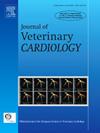Balloon aortic valvuloplasty for congenital aortic valvar stenosis in 10 dogs
IF 1.3
2区 农林科学
Q2 VETERINARY SCIENCES
引用次数: 0
Abstract
Introduction/Objectives
Aortic valvar stenosis (AS) is an uncommon congenital defect in the dog, but when present, it can cause severe clinical signs including collapse and congestive heart failure. In human patients, AS is a common congenital defect that has been managed with balloon aortic valvuloplasty (BAV). The objectives of this study were to describe the procedural details and retrospectively evaluate the outcomes of dogs with severe AS that underwent BAV.
Animals
Ten client-owned dogs diagnosed with severe AS.
Materials and Methods
Medical records and stored images from echocardiographic and angiographic examinations were reviewed from dogs that were diagnosed with severe AS and underwent BAV. The severity of velocity-derived maximal systolic pressure gradient across the aortic valve and aortic insufficiency was assessed from transthoracic echocardiographic images before and after BAV. Procedural details from the BAV procedures including intra-operative complications, type and size of the balloon catheter used, and use of rapid right ventricular pacing were recorded.
Results
The median (range) age and weight at the time of BAV were 12 months (6–120 months) and 18.2 kg (4.8–33.0 kg), respectively. Most dogs had high-pressure balloon dilation catheters used (n = 6/10) during BAV, and the balloon diameter-to-aortic annular ratio was 1.03 ± 0.05 for all dogs. The maximal systolic pressure gradient across the aortic valve decreased from 183.2 mmHg ± 74.6 before BAV to 97.4 mmHg ± 48.2 immediately after BAV (P<0.001). The severity of aortic insufficiency did not significantly worsen after BAV (P=0.25). The long-term impact of BAV on survival is unknown, and this could be considered a limitation of this study.
Study Limitations
This study describes the short-term effects of BAV for dogs with AS, and a lack of long-term follow-up may be considered a limitation.
Conclusions
Balloon aortic valvuloplasty for severe AS is tolerated in most dogs, and dogs with severe AS may benefit from transcatheter BAV.
球囊主动脉瓣成形术治疗先天性主动脉瓣狭窄10例
主动脉瓣狭窄(aortic valvar stenosis, AS)是犬的一种罕见的先天性缺陷,但当它出现时,可引起严重的临床症状,包括虚脱和充血性心力衰竭。在人类患者中,AS是一种常见的先天性缺陷,已通过球囊主动脉瓣成形术(BAV)进行治疗。本研究的目的是描述程序细节,并回顾性评估严重AS犬接受BAV的结果。动物:客户的狗被诊断患有严重的阿斯伯格综合症。材料与方法对诊断为严重AS并行BAV的犬进行病历和存储的超声心动图和血管造影检查。通过BAV前后经胸超声心动图评估经主动脉瓣速度源性最大收缩压梯度和主动脉功能不全的严重程度。记录BAV手术的细节,包括术中并发症、球囊导管的类型和大小以及右心室快速起搏的使用。结果BAV发生时的中位(范围)年龄为12个月(6 ~ 120个月),体重为18.2 kg (4.8 ~ 33.0 kg)。BAV时大多数犬使用高压球囊扩张导管(n = 6/10),球囊直径与主动脉环的比值为1.03±0.05。主动脉瓣最大收缩压梯度从BAV前的183.2 mmHg±74.6降至BAV后立即的97.4 mmHg±48.2 (P<0.001)。BAV后主动脉功能不全的严重程度没有明显恶化(P=0.25)。BAV对生存的长期影响尚不清楚,这可能被认为是本研究的局限性。本研究描述了BAV对AS犬的短期影响,缺乏长期随访可能被认为是一个局限性。结论大多数犬对严重AS的球囊主动脉瓣成形术是耐受的,严重AS的犬可能从经导管BAV中获益。
本文章由计算机程序翻译,如有差异,请以英文原文为准。
求助全文
约1分钟内获得全文
求助全文
来源期刊

Journal of Veterinary Cardiology
VETERINARY SCIENCES-
CiteScore
2.50
自引率
25.00%
发文量
66
审稿时长
154 days
期刊介绍:
The mission of the Journal of Veterinary Cardiology is to publish peer-reviewed reports of the highest quality that promote greater understanding of cardiovascular disease, and enhance the health and well being of animals and humans. The Journal of Veterinary Cardiology publishes original contributions involving research and clinical practice that include prospective and retrospective studies, clinical trials, epidemiology, observational studies, and advances in applied and basic research.
The Journal invites submission of original manuscripts. Specific content areas of interest include heart failure, arrhythmias, congenital heart disease, cardiovascular medicine, surgery, hypertension, health outcomes research, diagnostic imaging, interventional techniques, genetics, molecular cardiology, and cardiovascular pathology, pharmacology, and toxicology.
 求助内容:
求助内容: 应助结果提醒方式:
应助结果提醒方式:


